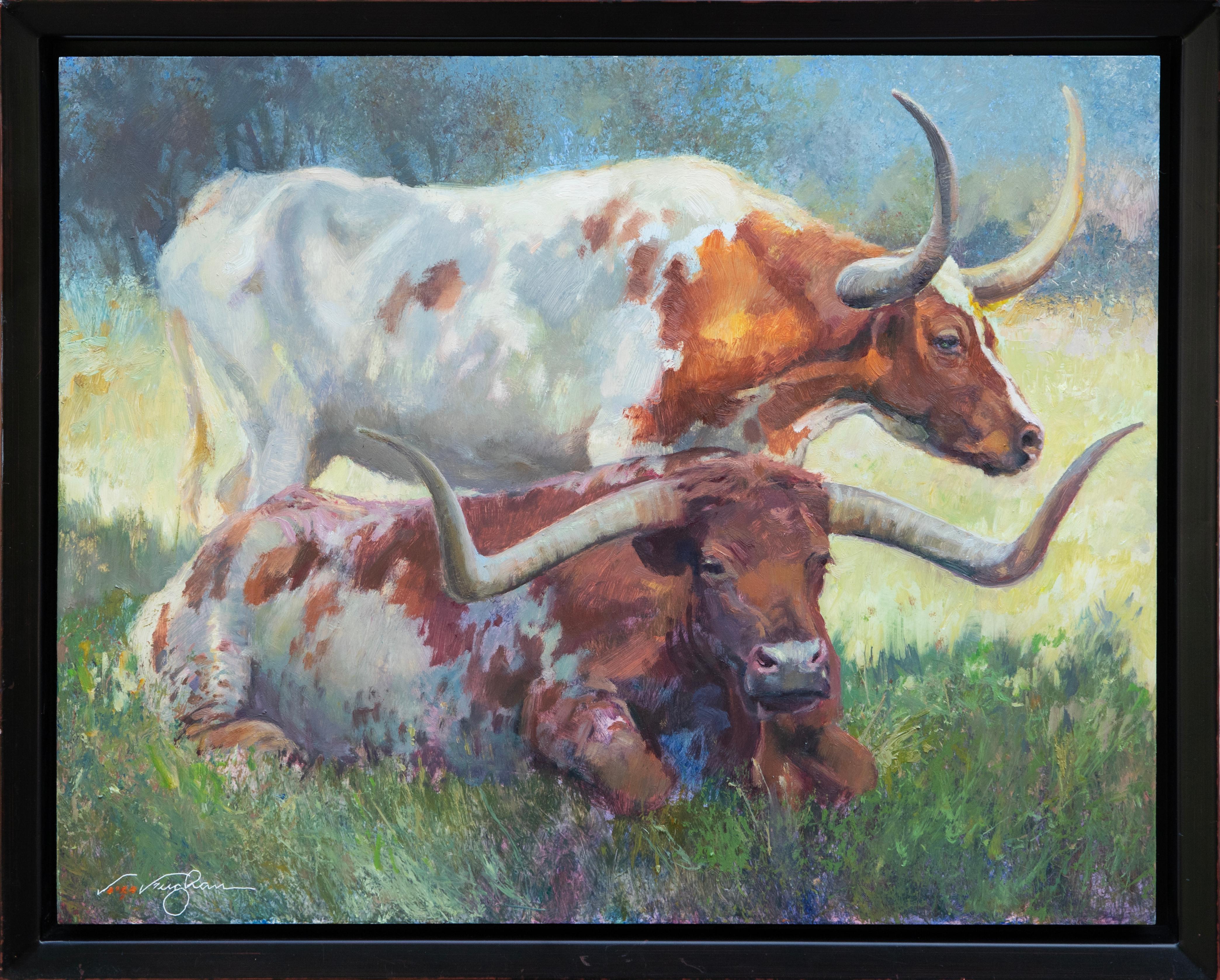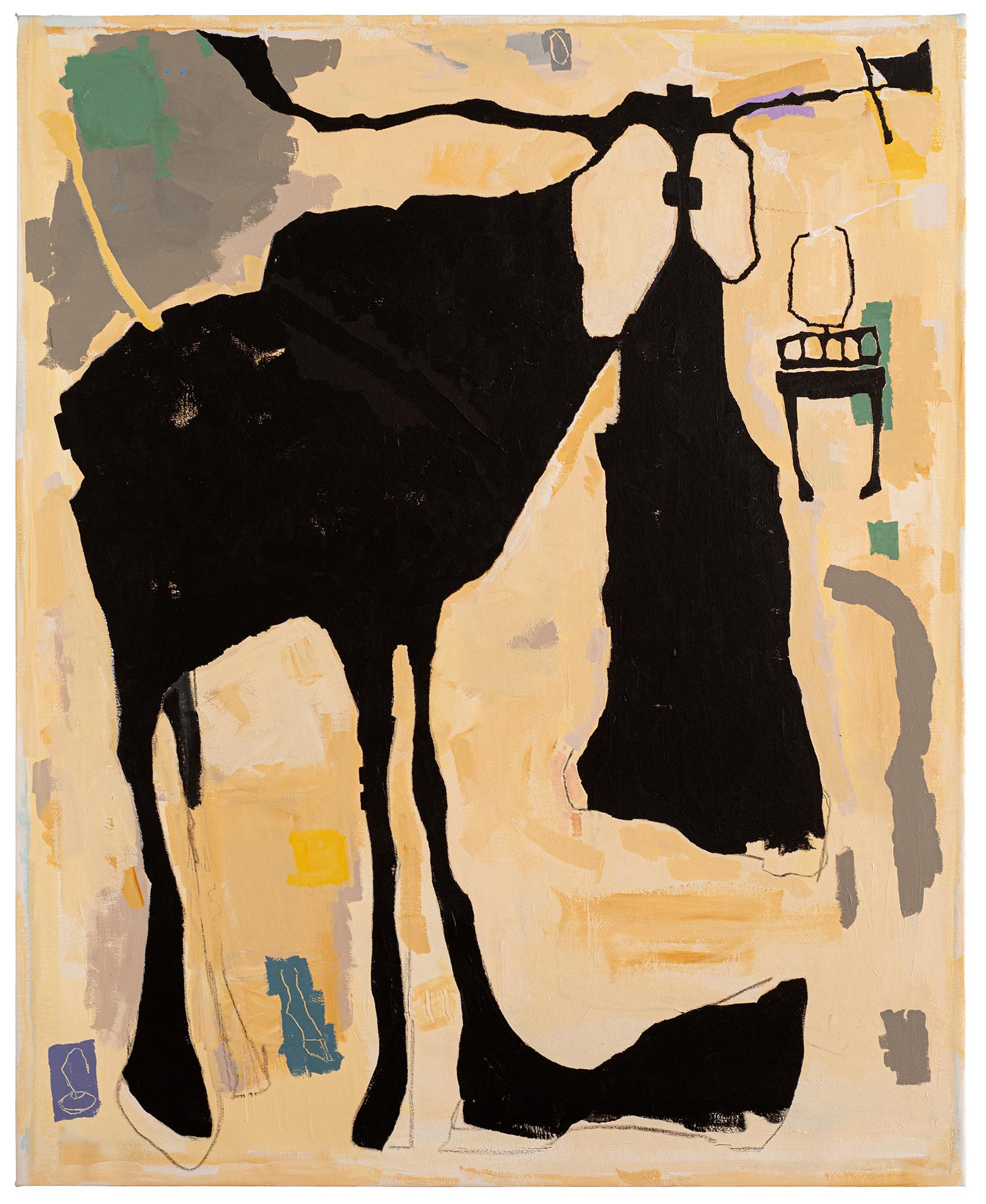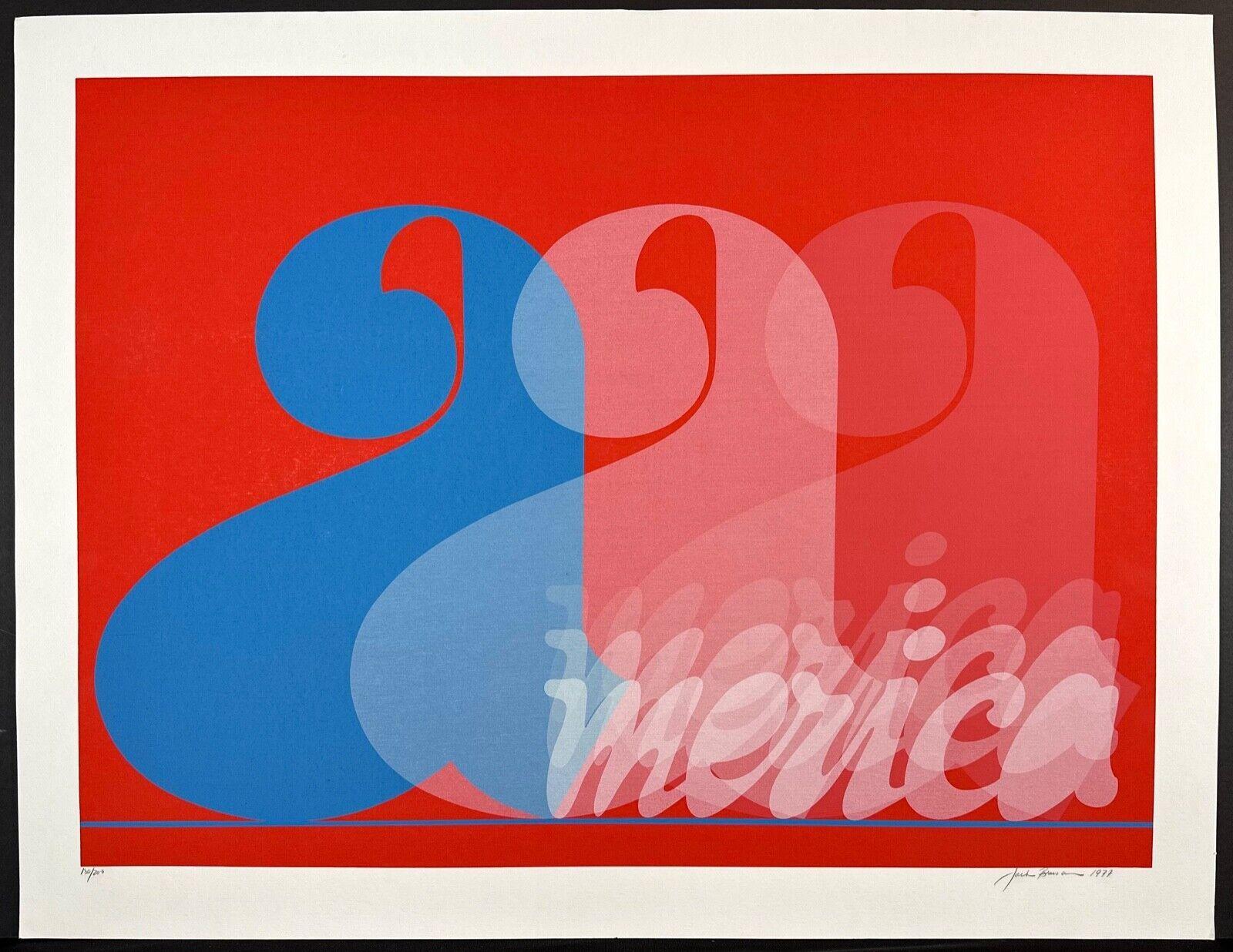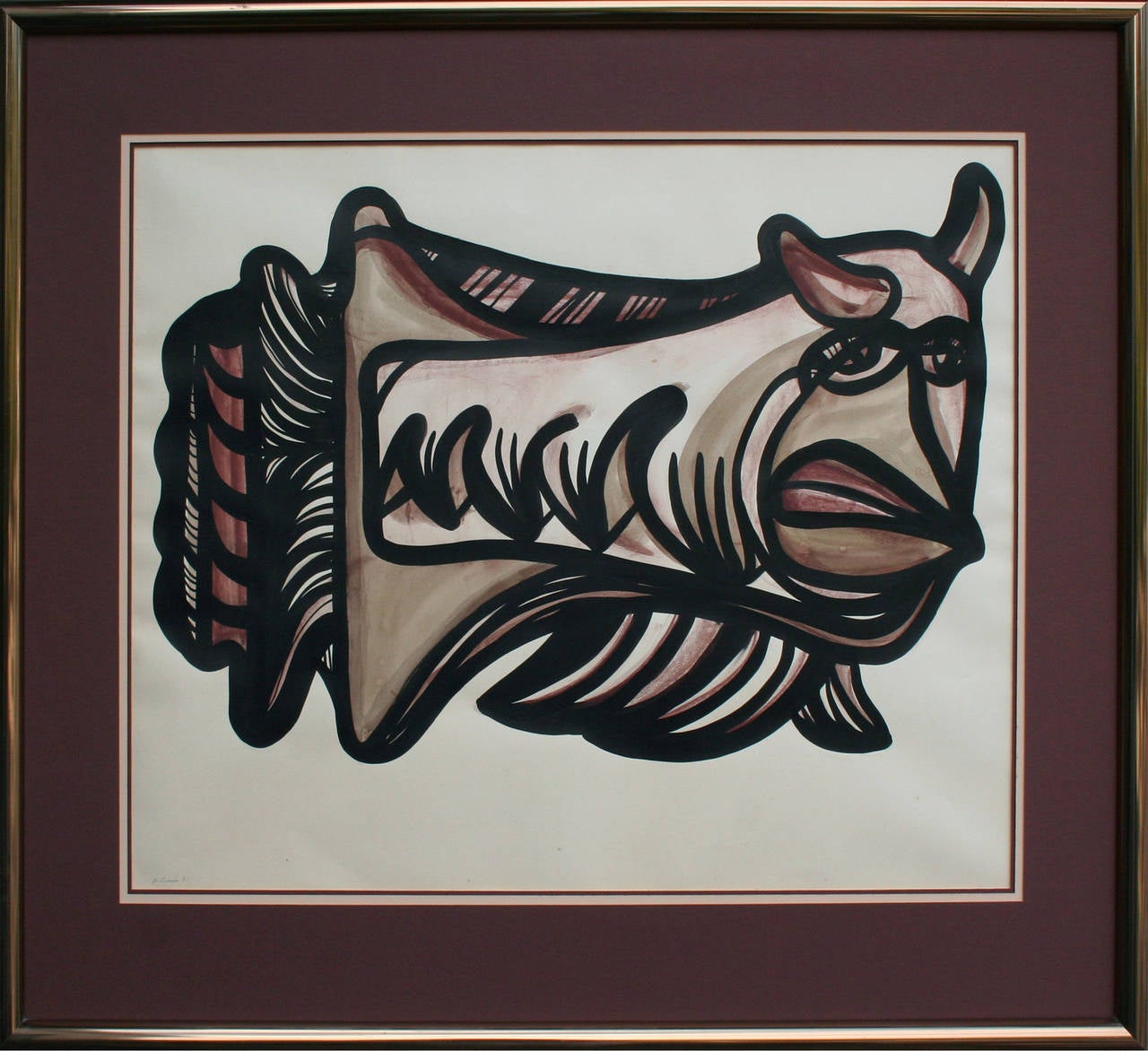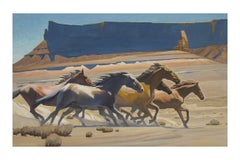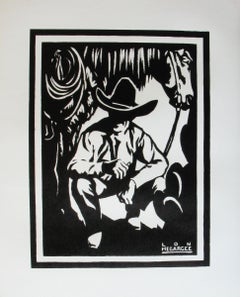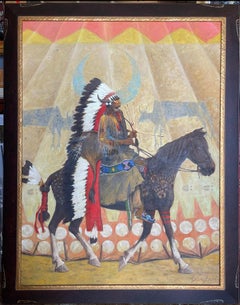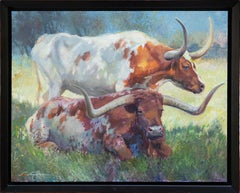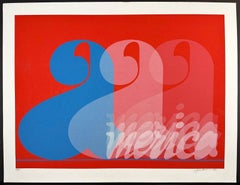Want more images or videos?
Request additional images or videos from the seller
1 of 5
Lon Megargee2 Lazy 2 P1940
1940
$1,800
£1,371.89
€1,568.16
CA$2,532.49
A$2,774.26
CHF 1,460.26
MX$33,111.53
NOK 18,614.65
SEK 17,016.60
DKK 11,713.86
About the Item
2 Lazy 2P, ca. 1939
Lon Megargee
Serigraph
20 x 24 inches
Signed in screen
Original serigraph print by Lon Megargee 1883 - 1960
Featured in "Hot Irons" by Oren Arnold and John Hale, 1940
SHIPPING CHARGES INCLUDE SHIPPING, PACKAGING & INSURANCE
Lon Megargee created this serigraph from his commission with Oren Arnold and John Hale to do their dust jacket for the book, " Hot Irons", 1940. Arnold and Hale wanted to establish a reference work, an "authority", with a entertaining history about the evolution of the brand. Megargee created a painting of a steer that was branded with the script, 2 Lazy 2 P. Surrounding the steer is a random display of famous brands of ranches in the Southwest. It was well received and must have prompted Megargee to create the likeness as a print.
The brand is described in chapter thirteen, page 207-208 and says, " Ed Stram, who was Arizona state veterinarian for sixteen years, fire-branded his cattle with this peculiar crest. It isn't peculiar unless you have an equally peculiar sense of humor. At a glance it appears to be just another typically unimaginative brand, but it has been used to make many a thousand girls blush, and a few thousand bashful young men as well".
COLLIER GALLERY, FINE ART ESTATE OF LON MEGARGEE
Born and raised in Philadelphia, Pennsylvania, Lon Megargee, at age 13, ran away from his upper class home and went West in 1896 led by his zest for the wild and adventuresome life. There he established a reputation as a cowboy painter and illustrator with work most associated with Arizona Brewing Company ads featuring humorous aspects of cowboy life.
In his youth, he worked as a free-lance cowboy, exhibition roper, poker dealer, and bronco buster in Arizona, and then went east again to study art in Philadelphia at the Pennsylvania Academy of Fine Arts, and to New York at the Art Students League and Pratt Institute.
He returned to Arizona, living in Cave Creek, Salt River Canyon, Phoenix and the last years of his life near Sedona. His Phoenix home later became a popular hotel and dining place called the Hermosa Inn.
Megargee was a ranch owner and also did oil canvases of the places he loved and the cowboy life he admired. By 1910, he was among the earliest resident artists, and was probably the best known artist in Arizona. His name was first associated with a landscape series of 15 large murals for the Capitol Building, newly constructed just after Arizona became a state in 1912. Another one of his paintings, Elemental, was the first painting by an artist living in Arizona to be acquired for the Municipal Collection of Phoenix. These works were chosen from entries in the State Fair, where he continued to win prizes for figure and landscape painting.
From 1911 to 1953, he did numerous commission works for the Santa Fe Railroad, including a work titledNavajos Watching a Santa Fe Train. Between 1915 and 1930, he also painted in the Los Angeles area of California and had entries in the California State Fair. He died in Cottonwood, Arizona. After his death, theSaturday Evening Post had a double-page reproduction of his painting Cowboy's Dream.
Creator of the iconic logo for the Stetson Hat Company, " Last Drop From his Stetson", still in use today.
Fine Art Estate of Lon Megargee
We offer signed in print and original signature block prints. Custom, hand carved, signature frames, with archival standards and a speciality in hand dyed mats and french matting are provided for a beautiful and timeless presentation.
Megargee explored different mediums; printmaking captivated him in particular. The contrast of the black and white block print method captured perfectly his interpretation of a bold American West. The first print was produced around 1921 and culminated with the creation of “The Cowboy Builds a Loop” in 1933 with 28 images and poetry by his friend, Roy George. Megargee continued producing prints throughout the 1940s and early 50s.
At age 13, Lon Megargee came to Phoenix in 1896 following the death of his father in Philadelphia. For several years he resided with relatives while working at an uncle’s dairy farm and at odd jobs. He returned to Philadelphia in 1898 – 1899 in order to attend drawing classes at the Pennsylvania Academy of the Fine Arts. Back in Phoenix in 1899, he decided at the age of 16 to try to make his living as a cowboy. Lon moved to the cow country of Wickenburg where he was hired by Tex Singleton’s Bull Ranch. He later joined the Three Bar Ranch . . . and, after a few years, was offered a job by Billy Cook of the T.T. Ranch near New River. By 1906, Megargee had learned his trade well enough to be made foreman of Cook’s outfit. Never shy about taking risks, Lon soon left Cook to try his own hand at ranching. He partnered with a cowpuncher buddy, Tom Cavness, to start the El Rancho Cinco Uno at New River. Unfortunately, the young partners could not foresee a three-year drought that would parch Arizona, costing them their stock and then their hard-earned ranch.
Breaking with his romantic vision of cowboy life, Megargee finally turned to art full time. He again enrolled at the Pennsylvania Academy and then the Los Angeles School of Art and Design during 1909 – 1910. The now well-trained student took his first trip to paint “en plein air” (outdoors) to the land of Hopi and Navajo peoples in northern Arizona. After entering paintings from this trip in the annual Territorial Fair at Phoenix, in 1911, he surprisingly sold his first oil painting to a major enterprise – the Santa Fe Railroad . . . Lon received $50 for “Navajos Watching the Santa Fe Train.” He soon sold the SFRR ten paintings over the next two years. For forty years the railroad was his most important client, purchasing its last painting from him in 1953.
In a major stroke of good fortune during his early plein-air period, Megargee had the opportunity to paint with premier artist, William R. Leigh (1866 – 1955). Leigh furnished needed tutoring and counseling, and his bright, impressionistic palette served to enhance the junior artist’s sense of color and paint application. In a remarkable display of unabashed confidence and personable salesmanship, Lon Megargee, at age 30, forever linked his name with Arizona art history. Despite the possibility of competition from better known and more senior artists, he persuaded Governor George Hunt and the Legislature in 1913 to approve 15 large, historic and iconic murals for the State Capitol Building in Phoenix. After completing the murals in 1914, he was paid the then princely sum of roughly $4000. His Arizona statehood commission would launch Lon to considerable prominence at a very early point in his art career.
Following a few years of art schooling in Los Angeles, and several stints as an art director with movie studios, including Paramount, Megargee turned in part to cover illustrations for popular Western story magazines in the 1920s.
In the 1920s, as well, Lon began making black and white prints of Western types and of genre scenes from woodblocks. These prints he generally signed and sold singly. In 1933, he published a limited edition, signed and hard-cover book (about 500 copies and today rare) containing a group of 28 woodblock images. Titled “The Cowboy Builds a Loop,” the prints are noteworthy for strong design, excellent draftsmanship, humanistic and narrative content, and quality. Subjects include Southwest Indians and cowboys, Hispanic men and women, cattle, horses, burros, pioneers, trappers, sheepherders, horse traders, squaw men and ranch polo players. Megargee had a very advanced design sense for simplicity and boldness which he demonstrated in how he used line and form. His strengths included outstanding gestural (action) art and strong figurative work. He was superb in design, originality and drawing, as a study of his prints in the Hays collection reveals.
In 1944, he published a second group of Western prints under the same title as the first. Reduced to 16 images from the original 28 subjects, and slightly smaller, Lon produced these prints in brown ink on a heavy, cream-colored stock. He designed a sturdy cardboard folio to hold each set. For the remainder of his life, Lon had success selling these portfolios to museum stores, art fairs and shows, and to the few galleries then selling Western art.
Drawing on real working and life experiences, Lon Megargee had a comprehensive knowledge, understanding and sensitivity for Southwestern subject matter. Noted American modernist, Lew Davis (1910 – 1979), helped to explain the uniqueness, strength and character of Megargee’s art in a 1975 interview with an Arizona publication: “His restless independence as a man and an artist was clear then (before WWI) and remained so until his death. Always one characteristic stood out. He was indigenous. He belonged here. Not a carpetbagger with a paint box, or a disillusioned urbanite seeking a new life, but an artist who used what he knew and had lived to put down what he had seen.”
From the origins of his career in art, Lon Megargee had a strong sense of the importance and worthiness of contributions that had been made by Native Americans and Hispanics. Even when satirizing their actions and foibles, and those of his Anglo peers, Megargee in his art provided a fairness and balance to all creeds that was enlightened for its time.”
- Creator:Lon Megargee (1883 - 1960, American)
- Creation Year:1940
- Dimensions:Height: 20 in (50.8 cm)Width: 24 in (60.96 cm)
- Medium:
- Movement & Style:
- Period:
- Condition:
- Gallery Location:Phoenix, AZ
- Reference Number:1stDibs: LU2623215120432
About the Seller
No Reviews Yet
Vetted Professional Seller
Every seller passes strict standards for authenticity and reliability
1stDibs seller since 2023
8 sales on 1stDibs
- ShippingRetrieving quote...Shipping from: Phoenix, AZ
- Return Policy
More From This Seller
View AllMisfit by Greg Singley
Located in Phoenix, AZ
Title: Misfit
Artist: Greg Singley
Signed original signature
Archival Pigment Print,
100% Rag Paper 300 gm
Paper size: 24 x34 inches
Image Size: 20 x 30 inches
Greg Singley
Greg Singley – was born in 1950 in Greensboro, Alabama. He received his Associates Degree at Walker Collage Jasper Alabama and furthered his college education at the University of South Alabama, Mobile Alabama. He attended the revered Ringling School of Art for his art training in Sarasota Florida and graduated with honors with a certificate in commercial illustration.
In 1978 Singley moved to Phoenix Arizona to pursue his passion for western art and illustration. He worked for several years as an art director for Phoenix Public News and as a freelance illustrator and at the same time experienced sales of Native American and Western Landscape in several Arizona galleries which include Ratliff Williams Gallery, Sedona Arizona, Fagan Peterson Fine Art, Scottsdale and the Dan May Gallery, Scottsdale Arizona.
After a foray into freelance illustration Singley sought representation for his varied abilities and interest in fine art and found the Phoenix Art Group...
Category
2010s Contemporary Figurative Prints
Materials
Archival Pigment
Wide Open by Greg Singley
Located in Phoenix, AZ
Title: Wide Open
Artist: Greg Singley
Archival Pigment Print
100% Cotton Rag 300gm
Image size: 20 x 32.625
Paper size: 24 x 36 inches
Greg Singley
Greg Singley – was born in 1950 in Greensboro, Alabama. He received his Associates Degree at Walker Collage Jasper Alabama and furthered his college education at the University of South Alabama, Mobile Alabama. He attended the revered Ringling School of Art for his art training in Sarasota Florida and graduated with honors with a certificate in commercial illustration.
In 1978 Singley moved to Phoenix Arizona to pursue his passion for western art and illustration. He worked for several years as an art director for Phoenix Public News and as a freelance illustrator and at the same time experienced sales of Native American and Western Landscape in several Arizona galleries which include Ratliff Williams Gallery, Sedona Arizona, Fagan Peterson Fine Art, Scottsdale and the Dan May Gallery, Scottsdale Arizona.
After a foray into freelance illustration Singley sought representation for his varied abilities and interest in fine art and found the Phoenix Art Group...
Category
2010s Contemporary Figurative Prints
Materials
Archival Pigment
Longhorns by Lon Megargee
Located in Phoenix, AZ
Lon Megargee 1883-1960
"Self Portrait"
Wood block print
Signed in plate, lower right
Image size: 15.63 x 12 inches
Frame size xx x xx inches
Creator of S...
Category
1930s American Impressionist Animal Prints
Materials
Screen
Painted Lodge by Greg Singley
Located in Phoenix, AZ
Greg Singley , born 1950-
Artist Statement:
When the sun sets in the desert South West, things appear. This is the nature of what touches me about that la...
Category
2010s Contemporary Figurative Paintings
Materials
Oil
Let the Devil Take Tomorrow by Greg Singley
Located in Phoenix, AZ
SHIPPING FEES INCLUDE SHIPPING CHARGE, PACKAGING & **INSURANCE**
Let the Devil Take Tomorrow
Greg Singley
Signed: Lower right
Archival Pigment Print
Image size: 28 x 22 inches
Pape...
Category
2010s Contemporary Figurative Prints
Materials
Digital, Digital Pigment
Western Flare
Located in Phoenix, AZ
Western Flare
Terrence Moore
Photograph, Archival Pigment Print
Size: 23 x 34.5 inches
SPECIAL EDITION OF 25, PRICE FOR THE HOLIDAYS
Terrence Moore ha...
Category
1970s Contemporary Color Photography
Materials
Archival Pigment
You May Also Like
All Day Long
Located in Colorado Springs, CO
Original oil painting on canvas by artist V.... Vaughan. Framed.
Category
21st Century and Contemporary Contemporary Animal Paintings
Materials
Canvas, Oil
Design For Living
Located in Red Bank, NJ
Outsider artist Scott Harbison imagines a world of curious alien beings and wide-eyed mutant animals, naively navigating unknown territory. His mischievous figures are activated by s...
Category
21st Century and Contemporary Outsider Art Animal Paintings
Materials
Canvas, Oil Crayon, Acrylic
America
By Jack Brusca
Located in Hollywood, FL
Artist: Jack Brusca
Title: America
Medium: Silkscreen
Signed: Hand Signed
Year: 1977
Edition: From the edition of 200
Measurements: 22" x 33 1/2"
Note: This piece is sold UNFRA...
Category
1970s Contemporary More Prints
Materials
Screen
My Wife Married a Lie
By Kim Yoakum
Located in San Francisco, CA
This artwork titled "My Wife Married a Lie" is a original color serigraph on Wove paper by American artist Kim Yoakum. It is hand signed and numbered 51/595 in pencil by the artist. ...
Category
Late 20th Century American Modern Figurative Prints
Materials
Screen
Little Ol' Tex
Located in Austin, TX
David Ackerson (b. 1950, American)
Title: "Little Ol' Tex"
Medium: Acrylic on Canvas
Size: 18 x 24 in.
Markings: Signed LR "David Ackerson"
Signed & Ti...
Category
21st Century and Contemporary Contemporary Animal Paintings
Materials
Canvas, Oil, Acrylic
Modernist Abstract Bull
By Dick Crispo
Located in Soquel, CA
Unique modernist depiction of an abstracted bull by California artist Dick Crispo (American, b.1945), 1981. The earthtoned animal is outlined in bold strokes of black, and is rendered in an interesting fractured geometric style evocative of cubism's handling of perspective.
Signed and dated lower left "D. Crispo '81", and on label on verso.
Presented in a dark copper metal frame.
Image size; 22.5"H x 28.75"L.
An award winning artist, Crispo has studied at the Carmel Art Institute under John Cunningham and Sam Colburn...
Category
1980s American Modern Animal Paintings
Materials
Tempera
More Ways To Browse
Railroad Watch
Vintage Bronco
Vintage Womens Hats 1940s Womens Hats
Vintage Stetson
Lon Megargee
Stetson Hat Vintage
Lew Davis
Cattle Brand
River Phoenix
Les Banderilles
Phyllis Lucas Gallery
Picasso Bull Lithograph
Salvador Dali Elephant
Salvador Dali Signed Prints Elephant
Vintage Beagle Art
African Hunting Art
Andy Warhol Cow Prints
Andy Warhol Cow
